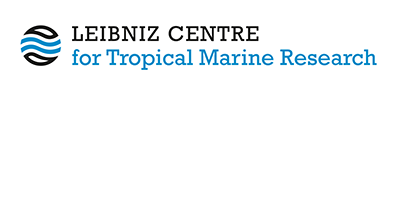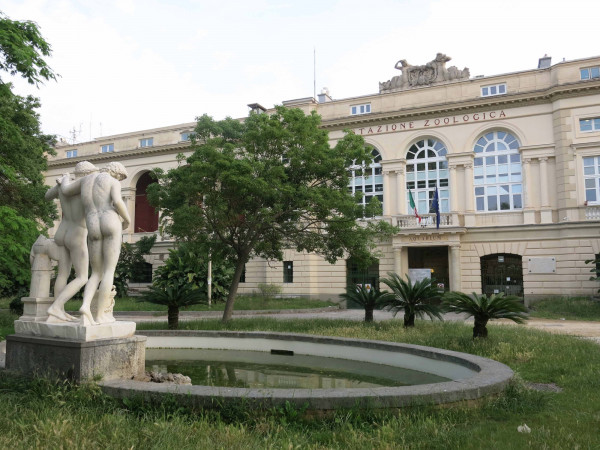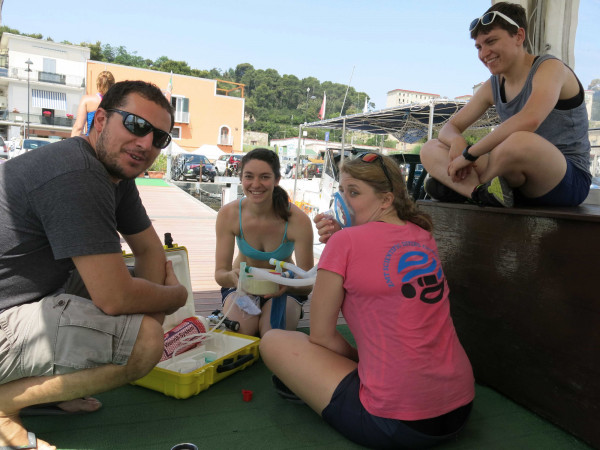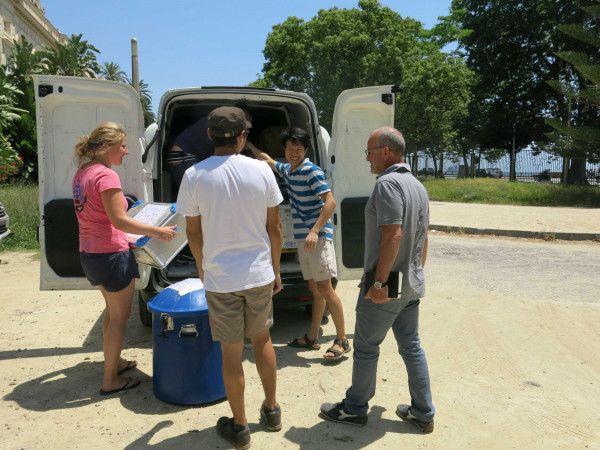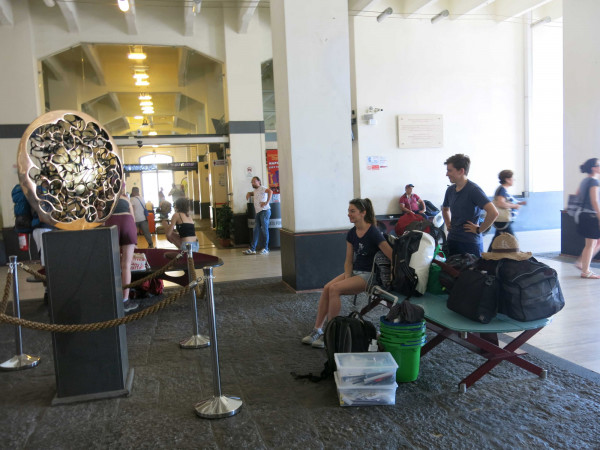SEANARIOS from Naples, Italy
10.06.19-13.06.19
The Stazione Zoologica Anton Dohrn, Napoli where the ZMT is hosted by the Italian research partners.
Photos by Stefanie Bröhl, Stephanie Helber, Mirta Teichberg and Natalie Prinz
„Divers descending!“ in the busy Gulf of Pozzuoli, a part of the larger Gulf of Naples, Italy, the dive team around post-doc Dr. Stephanie Helber is in action. The ultimate goal of this fieldtrip is to kick-off the SEANARIOS project, led by ZMTs WG Algae and Seagrass Ecology and WG Spatial Ecology and Interactions.
Stephanie arrived last week to Naples with BSc student Elliot Opätz to meet with the scientific partners, Dr. Gabriele Procaccini and Dr. Ulisse Cardini from the Stazione Zoologica Anton Dohrn, Naples and prepare all the materials needed for the experiments. The rest of the ZMT dive team, including Stefanie Bröhl and Natalie Prinz joined a week later. The aim of the field work is to deploy experimental plots in the slow-growing seagrass Posidonia oceanica beds at 8m depth for approximately 6 months and to collect initial samples of our selected field sites. The next step will be a trip to Israel to repeat the same procedures with a smaller fast-growing seagrass, Halophila stipulacea, in the Gulf of Aqaba, Red Sea with our partner Dr. Gidon Winters from the Dead-Sea & Arava Science Center.
The overall aim of the project is to compare the early response stages of seagrasses under climate change related temperature increase and nutrient enrichment. The field experiments led by ZMT complement mesocosm studies in the laboratory carried out by the Italian and Israeli partners. Data from these field and lab experiments will then be used to model seagrass response under future climate change conditions.
Here in Italy, we chose two sites near the urbanised shoreline, heavily influenced by anthropogenic activity, and two more pristine sites on the island of Ischia. For the field work, ZMT dive mission leader Stefanie Bröhl is connected to the dive buddy team with a communication line that enables easy audio communication during the dive. At each site, six plots are marked with steel rods and seagrass samples are collected for the analysis of the microbial communities, gene expression, biochemistry and PAM measurements. Additionally, the environmental water parameters are assessed. Once each site is set up, some plots will be fertilised to simulate enhanced nutrient input. For this, fertiliser tubes are deployed into the sea floor which will slowly release nutrients over the next few months.
Dr. Mirta Teichberg and Dr. Helber from the Algae and Seagrass Ecology Group at the ZMT hope to detect a set of early warning indicators for stress in seagrasses over the summer heat wave in the Gulf of Naples and Ischia. This field work trip is the first of two more to come in this site.
Natalie Prinz and Mirta Teichberg
13.06.19, Village live in South Italy
What was the main attraction of the year in the sleepy village of Baia? -Our dive team. We were observed with great interest in the housing complex where we had rented a small apartment. Almost every day something new was happening and we climbed up to our apartment with cooling boxes full of samples, various scientific equipment and buckets of Posidonia.
We started our initial sampling and the nutrient enrichment on our two impacted sites in the Gulf of Pozzuoli. Huge fields of mussel farms are next to our seagrass meadows and there are busy harbours in Baia and Misseno. As soon as we descended into the water, we could already see the impacts at our sites that resembled more Helgoland than beautiful Mediterranean waters. The water was turbid with lots of particles and maximum visibilities ranged around 6m. The seagrass plants were covered in filamentous epiphytes and the meadows were patchy.
After this experience we were excited to see how the seagrass plants around Ischia would look like.
Stephanie Helber
Packing the equipment with our partners from the Stazione.
17.06.19-18.06.19, Transport to Ischia
I arrived to Naples to join the SEANARIOS team after their first week of field work. All of the team was exhausted but happy to have completed the first 2 nearshore sites, including setting up the experiment and sampling Timepoint zero (T0). When I arrived to the station, they were repacking and discussing the plans for continuing the work around the island of Ischia, where we would continue with our pristine sites. Somehow, the boxes of equipment and dive gear seemed to be adding up, so finding a solution to get everything over to the island took a bit of creative thinking and trial and error. Finally, after loading all of our boxes onto a transport truck, we headed with our backpacks to the ferry terminal to make our way to the island. Along the way, we had a great chance to view the populated city of Naples and the whole coastline from the water. Natalie also pointed out to me the Gulf of Pozzuoli and the approximate location of our first two sites from afar.
After several connecting islands along the way, we finally reached Ischia, a volcanic island, first passing the Medieval “Castello Aragonese d´Ischia”, “Ischia Ponte”, or bridge to the old-town center and many seaside hotels and restaurants. Just before entering the harbor, we located the Stazione Zoologica Anton Dohrn-Ischia, an old red building on-top of an outcrop, the field station on the island. Once we arrived, we were met in the harbor by the Ischia Diving center and the head dive officer, Bruno Iacono of the Stazione. We unpacked all of the dive gear and equipment at the dive center and planned the next few days of field work together. We learned about a few important things of the island, including, the well-known underwater natural CO2 vents, the locations of Posidonia meadows and ofcourse the most important, where to get the best Italian food on the Island. Afterwards, we made our way up the winding streets to Via Michele Mazzella, our home for our stay on the island.
Mirta Teichberg
19.06.19, First field day on Ischia
The moment that you sit on the boat, wind in your face and a rising sun in the background illuminating the quiet morning scene of Ischia’s port makes you forget that you had to wake up way too early. It is the first of six dive days in Ischia and we are all very excited to see what it will bring. With the great help of the Diving Ischia Staff, we loaded the boat with all our boxes full of dive equipment, diving lines, spare ropes, cooling boxes and boxes filled with scientific bits and pieces, such as syringes, tubes and ziplock bags.
We leave the harbour past the Stazione and by turning towards the open ocean the scenery becomes even nicer: The sleepy Ischia is waking up to another busy summer day and we can observe the first cars and people from afar. Most impressing however is the Castello Aragonese, a castle like structure that was built into the tombolo and rises proudly in front of Ischia’s capital village. And then we already glide over the area that is covered with Posidonia. At the 10m depth line we try and find an appropriate place to anchor and start the dive operation. Everything goes smoothly and the first site on the island with its six plots is introduced. The meadow here is even for my eye that is new to seagrass ecology, much denser and greener compared to the Pozzuoli site. Needless to say, that when I broke through the surface on ascent immediately seeing the Castello, I felt grateful to be able to do work for a scientific purpose with such a view!
Natalie Prinz
